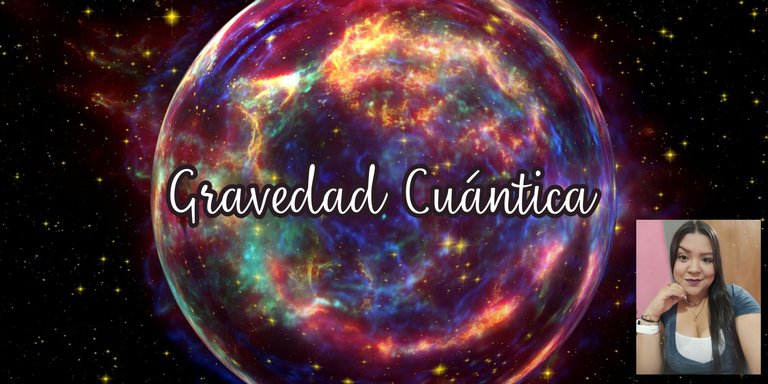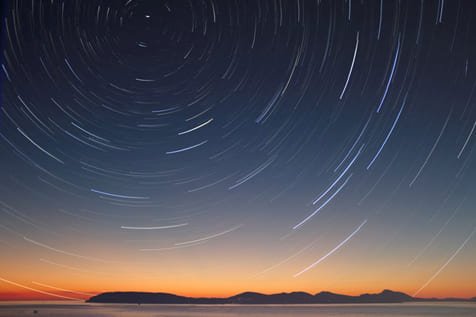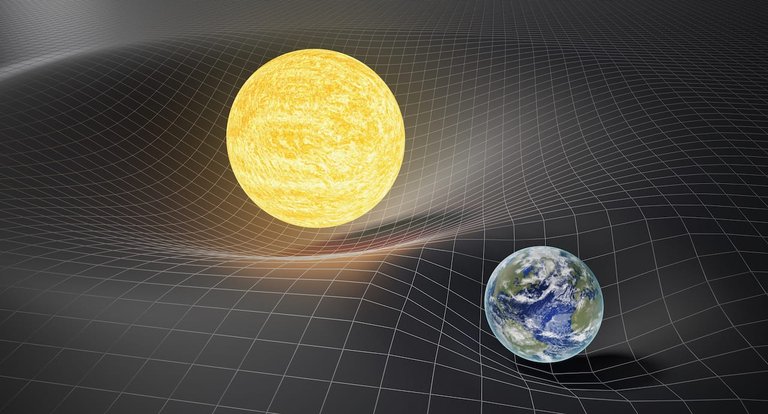Conozcamos sobre la Gravedad Cuántica // Let's learn about Quantum Gravity
¡Hola querida comunidad científica de #Hive, reciban todos un cordial saludo!🖐
Hello dear #Hive scientific community, receive warm greetings from all of you!🖐
Hace algunas semanas atrás estuvimos hablando un poco sobre la teoría de las cuerdas, y justo en ese desarrollo se hizo un comentario acerca de lo difícil que ha sido llevar a cabo una Teoría de Gravitación Cuántica. Pues resulta que aún en la actualidad la física enfrenta la difícil tarea de generar una unión entre la Relatividad General y la Mecánica Cuántica, a pesar de que hay grandes avances no se ha podido establecer una teoría certera.
A few weeks ago we were talking a little about string theory, and just in that development a comment was made about how difficult it has been to carry out a Theory of Quantum Gravitation. It turns out that even nowadays physics faces the difficult task of generating a union between General Relativity and Quantum Mechanics, although there are great advances, it has not been possible to establish an accurate theory of quantum gravitation.

Imagen realizada con la página web de diseño gráfico y composición de imágenes Canva // Image made with the graphic design and image composition website Canva.
Ahora bien, ¿Por qué se quiere describir la gravedad desde el punto de vista cuántico? En ocasiones decimos que muchas de las interrogantes de una investigación vienen de simple capricho o de pensamientos irracionales y la verdad es que no, en la ciencia siempre hay una razón de ser. En esta ocasión se pretende justamente generar una armonía, si analizamos un poco las demás interacciones fundamentales de la naturaleza como lo son la electromagnética, la nuclear fuerte y débil, ellas poseen una descripción cuántica satisfactoria conocidas desde hace varios años. Sin embargo, se esperaba que la interacción gravitatoria también pudiese tener su comprensión desde el punto de vista cuántico, pero esto no ha sido tan fácil.
En el día de hoy se utiliza la Teoría de la Relatividad General para describir la gravedad, ella ha sido correcta y podría decirse muy exitosa, pero la comunidad científica cree que no debería ser la última palabra. Cabe destacar que mediante la Teoría General se ha logrado conocer cosas como la luz puede presentar desviación cuando se encuentra en presencia de un campo gravitatorio, incluso cómo es el universo a gran escala y que ocurre alrededor de un agujero negro, pero la verdad es que existen muchas cosas más que no se han podido resolver y de verdad escapan de ella.
No obstante, los diferentes estudios que emergieron sobre cómo cuantizar la gravedad se les conoce como “Gravedad Cuántica”. Lo que se busca con ella es describir la gravedad haciendo uso de las teorías cuánticas, a pesar de que aún no se logra establecer una teoría que logré explicar esto de manera exitosa, si existen dos posibles caminos para ello, una de ellas es la teoría de las cuerdas y la otra es la gravedad cuántica de bucles.
Now, do we want to describe gravity from the quantum point of view? Sometimes we say that many of the questions of a research come from simple whim or irrational thoughts and the truth is that no, in science there is always a reason for being. On this occasion it is intended to generate a harmony, if we analyze a little the other fundamental interactions of nature such as electromagnetic, strong and weak nuclear, they have a satisfactory quantum description known for several years. However, it was expected that the gravitational interaction could also be understood from the quantum point of view, but this has not been so easy.
Today the Theory of General Relativity is used to describe gravity, it has been correct and arguably very successful, but the scientific community believes that it should not be the last word. It should be noted that through the General Theory it has been possible to know things like how light can present deviation when it is in the presence of a gravitational field, even how the universe is on a large scale and what happens around a black hole, but the truth is that there are many more things that have not been solved and really escape it.
However, the different studies that emerged on how to quantize gravity are known as “Quantum Gravity”. What is sought with it is to describe gravity using quantum theories, although it is not yet possible to establish a theory that can explain this successfully, there are two possible ways to do it, one of them is the string theory and the other is the quantum gravity of loops.

Source
Para los científicos dedicados a la física de partículas, o física de altas energías como se le denomina a la gravedad, resulta ser la última y más débil de las interacciones. Para algunos científicos resulta fácil describir los formalismos cuánticos siguiendo un camino igual al de las otras interacciones. No obstante, para lograr cuantizar la gravedad, esto conlleva a buscar una teoría de campos convencional, en dicha búsqueda surge la teoría de las cuerdas.
Según la teoría de las cuerdas la gravedad es una excitación posible de sus cuerdas y el problema de dicha interacción puede reducirse a cómo este fenómeno de excitación da lugar a los fenómenos que hoy día conocemos. Sin embargo, para quienes estudian la Relatividad General, la manera de describir la gravedad en términos de excitación de un campo en el fondo donde ocurren las cosas, entonces como actualmente funciona la teoría cuántica resulta ser incorrecto desde la física. Pues resulta, que el universo es más complicado de lo que pensamos y esa opción simplificada de las cuerdas no da espacio a qué las leyes de la física ocurran. Los científicos que defienden la Relatividad el poder entender el cosmos implica el descubrimiento de algunas nociones clásicas sobre el tiempo y el espacio que resultan ser incorrectas al nivel fundamental y que necesitan pasar por algunas modificaciones en la mente y aprender abordarlas desde las teorías cuánticas.
Por lo tanto, el problema de la gravedad consiste en profundizar más en la revolución de los conceptos de la relatividad y la física cuántica. Ahora bien, en vista que se necesita un cambio de conceptos, la teoría de Einstein busca una nueva síntesis que vuelva a definir la concepción básica del espacio y el tiempo, incluso lo que ya se conoce desde la Relatividad General y la Mecánica cuántica. Aunado a todo esto, la teoría cuántica de bucles no inicia con ningún espacio-tiempo que actúe como fondo fijo del resto de leyes de la naturaleza.
For scientists engaged in particle physics, or high-energy physics as gravity is called, it turns out to be the last and weakest of the interactions. For some scientists, it is easy to describe quantum formalisms by following the same path as the other interactions. However, in order to quantize gravity, this leads to the search for a conventional field theory, and in this search, string theory arises.
According to string theory gravity is a possible excitation of its strings and the problem of such an interaction can be reduced to how this excitation phenomenon gives rise to the phenomena we know today. However, for those who study General Relativity, the way to describe gravity in terms of excitation of a field in the background where things happen, then how quantum theory actually works turns out to be incorrect from physics. As it turns out, the universe is more complicated than we think and that simplified string option does not give room for the laws of physics to occur. Scientists who defend Relativity in order to understand the cosmos imply the discovery of some classical notions about time and space that turn out to be incorrect at the fundamental level and that need to go through some modifications in the mind and learn to approach them from quantum theories.
Therefore, the problem of gravity is to further deepen the revolution of the concepts of relativity and quantum physics. Now, in view of the need for a change of concepts, Einstein's theory seeks a new synthesis that redefines the basic conception of space and time, including what is already known from General Relativity and Quantum Mechanics. In addition to all this, the quantum loop theory does not start with any space-time acting as a fixed background for the rest of the laws of nature.

Source
Es propicio resaltar que el estado actual de las teorías que intentan describir la gravedad resulta ser solo una especulación, aún no hay nada cierto. Sin embargo, aunque la teoría de las cuerdas y la teoría cuántica de bucles sean las vertientes más satisfactorias, también existe la posibilidad de que ambas resulten ser incorrectas o insuficientes. Pero, la teoría de las cuerdas si logra unificar las física más fundamental en un solo formalismo, pero es errónea cuando se trabaja con escalas muy pequeñas. De tal manera, la teoría de bucles logra proponer una formulación rigurosa e independiente de cualquier fondo y permite describir el universo a escalas muy pequeñas, pero en aspectos dinámicos la teoría es insuficiente.
No obstante, creo que estás dos teorías no deben ser aisladas una de la otra, podrían ser complementadas entre sí, pues la verdad manejan mucha similitud. Para excitación es a escalas más pequeñas resultan ser objetos unidimensionales, en una de habla de cuerdas y en la otra de bucles.
It is appropriate to point out that the current state of theories that attempt to describe gravity turns out to be only speculation, nothing is certain yet. However, although string theory and quantum loop theory are the most satisfactory approaches, there is also the possibility that both may prove to be incorrect or insufficient. But, string theory does manage to unify the most fundamental physics in a single formalism, but it is wrong when working with very small scales. In such a way, loop theory succeeds in proposing a rigorous formulation independent of any background and allows describing the universe at very small scales, but in dynamical aspects the theory is insufficient.
Nevertheless, I believe that these two theories should not be isolated one from the other, they could complement each other, because they are very similar. For excitation at smaller scales they turn out to be one-dimensional objects, in one of them speaking of strings and in the other of loops.
Ya para despedirme, agradezco a quienes se tomarnos unos minutos de su tiempo para leer mi publicación y me encantaría poder leer en los comentarios sus opiniones e impresiones sobre el tema.
In closing, I would like to thank those of you who took a few minutes of your time to read my publication and I would love to read in the comments your opinions and impressions on the subject.
Referencias
Gonzálvez, J. (2010). Introducción a la Teoría Cuántica de Bucles [Documento en línea] Disponible en:
References
Gonzálvez, J. (2010). Introduction to Quantum Loop Theory [Online document] Available at:.
Translator Deepl


Posted Using InLeo Alpha
https://x.com/ILovePhysica/status/1855047884238209530?t=to6rkjf8Uxoj5UeUdase2A&s=19
¡Hola! ¿Podrías revisar el artículo? Hay un párrafo al que no se realizó su traducción al inglés. Seguramente fue un descuido, muy simple de solucionar editándolo 😊.
Thanks for your contribution to the STEMsocial community. Feel free to join us on discord to get to know the rest of us!
Please consider delegating to the @stemsocial account (85% of the curation rewards are returned).
You may also include @stemsocial as a beneficiary of the rewards of this post to get a stronger support.
¡Felicitaciones!
Estás participando para optar a la mención especial que se efectuará el domingo 10 de noviembre del 2024 a las 8:00 pm (hora de Venezuela), gracias a la cual el autor del artículo seleccionado recibirá la cantidad de 1 HIVE transferida a su cuenta.
¡También has recibido 1 ENTROKEN! El token del PROYECTO ENTROPÍA impulsado por la plataforma Steem-Engine.
1. Invierte en el PROYECTO ENTROPÍA y recibe ganancias semanalmente. Entra aquí para más información.
2. Contáctanos en Discord: https://discord.gg/hkCjFeb
3. Suscríbete a nuestra COMUNIDAD y apoya al trail de @Entropia y así podrás ganar recompensas de curación de forma automática. Entra aquí para más información sobre nuestro trail.
4. Visita nuestro canal de Youtube.
Atentamente
El equipo de curación del PROYECTO ENTROPÍA